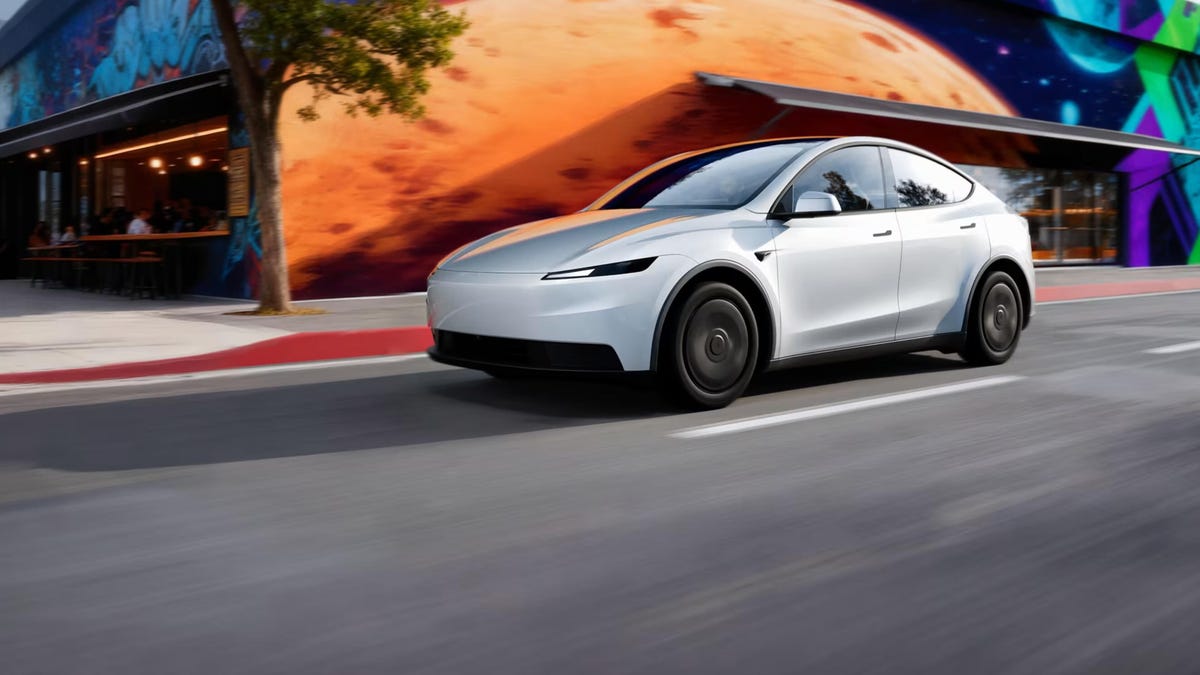Technologies
Gmail AI Can Now Write Emails for You on Your Phone: How It Works
Tired of writing boring emails? Google’s new Help Me Write feature has you covered.
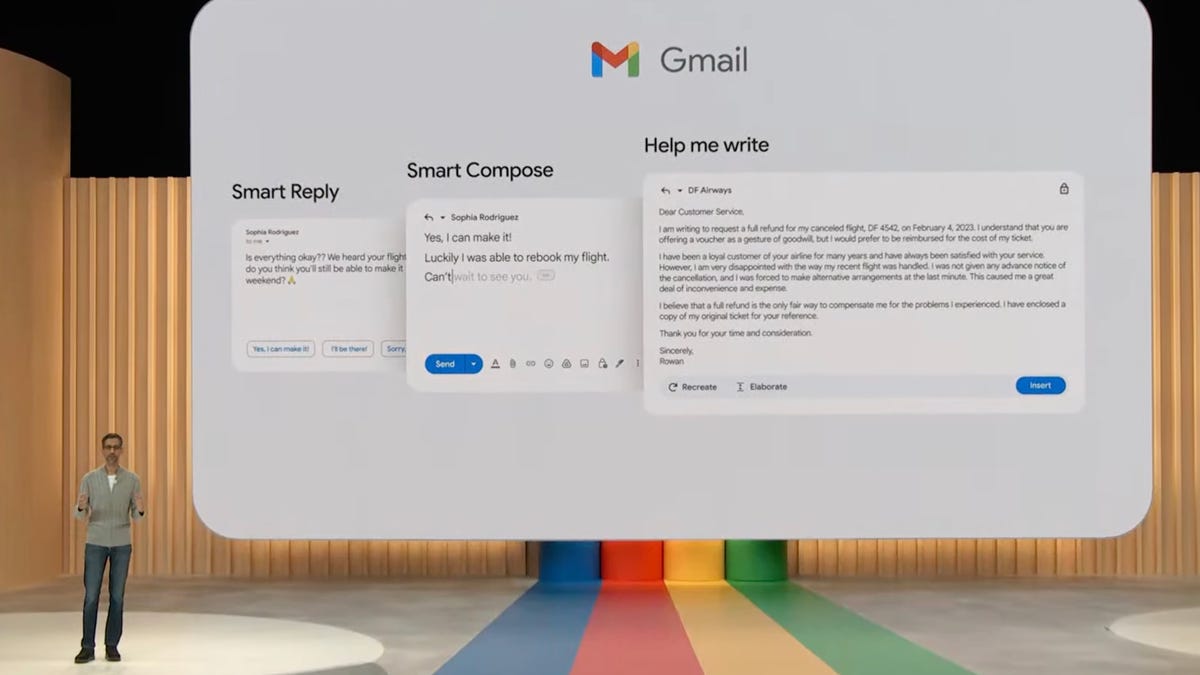
Email can be a lot of fun if you’re corresponding with an old friend or a pen pal halfway around the world. It’s less fun when you’re filing multiple insurance claims or sending hundreds of thank you notes.
Announced at the Google I/O event in May, a new feature from Gmail called Help Me Write can draft those boring emails for you. Powered by the company’s proprietary AI, the new Google service can compose automated messages in Gmail, text messages and other Google apps. Starting today, the feature is now available for Gmail on iPhones, iPads and Android devices.
With 1.8 billion active users of Gmail at the last count, Help Me Write is poised to have a major impact on the way that the world communicates via email. Learn more about how Help Me Write works and how you might use it.
For more on Google I/O, learn all about the foldable Pixel phone and the biggest new features announced for Android.
More from Google I/O
How does Help Me Write work in Gmail?
The new Help Me Write feature for generative AI email creation in Gmail expands on the «Smart Compose» feature that Google introduced in 2018, as well as the «Smart Reply» feature added in 2017.
Whereas Smart Reply offers basic automated replies, and Smart Compose provides suggestions as you type, Help Me Write goes well beyond, creating a full email from a basic prompt. A «refine» button can shorten the text, elaborate or make the email more formal. You can then further edit the email manually or send it as is.
In his demo at Google I/O, Pichai used Help Me Write to draft an email asking for a full refund from an airline for a canceled flight. Help Me Write created an email from scratch using information gleaned from the airline’s emailed offer of a voucher.
From Smart Reply ➡️ “Help me write” in Gmail 🧵↓#GoogleIO pic.twitter.com/u0ILECSMN4
— Google (@Google) May 10, 2023
How can I start using Help Me Write in Gmail?

Help Me Write is part of Google’s Workspace Labs, and you’ll need to join the program if you want to use AI to compose text in Gmail or Google Docs. Visit labs.withgoogle.com, scroll down to the section marked «Unlock new ways of working with AI» and click the blue «Join waitlist» button to sign up. (We were able to join Workspace Labs from a personal Google account today, immediately, without any wait.)
It’s worth noting that Google’s privacy policy for Workspace Labs is different to its standard Gmail privacy policy. The company takes pains to warn users, «Please do not include sensitive, confidential, or personal information that can be used to identify you or others in your interactions with Workspace Labs features.» Your Workspace Labs data may be reviewed by humans and stored by the company for four years.
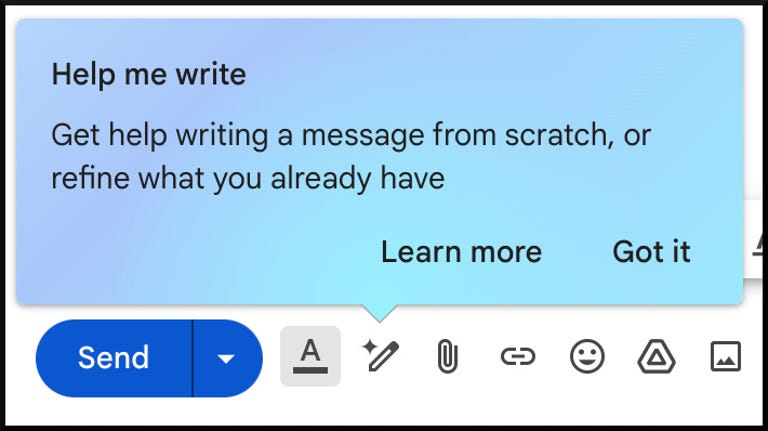
The Help Me Write button shows up next to the Send button in web-based Gmail.
Once you’re into Workspace Labs, a new Help Me Write icon — a pencil with a star above it — should show up whenever you draft a new email in Gmail or create a new document in Google Docs. In web-based Gmail, the icon appears to the right of the «Send» button. On your iPhone or Android device, it will show up at the bottom of the email.
Clicking on the Help Me Write button in Gmail will open up a prompt window, where you can describe what you want the AI to write. Provided examples include «A glowing review for a team member» and «Wish my friend a speedy recovery in the hospital.»
After you enter a prompt and click «Create,» Help Me Write will generate your text and provide you the options of recreating the text or refining it to make it more formal, more elaborate or shorter. Once you’re satisfied with the text, hit «Insert» to add it to your email, which you can then edit as you like.
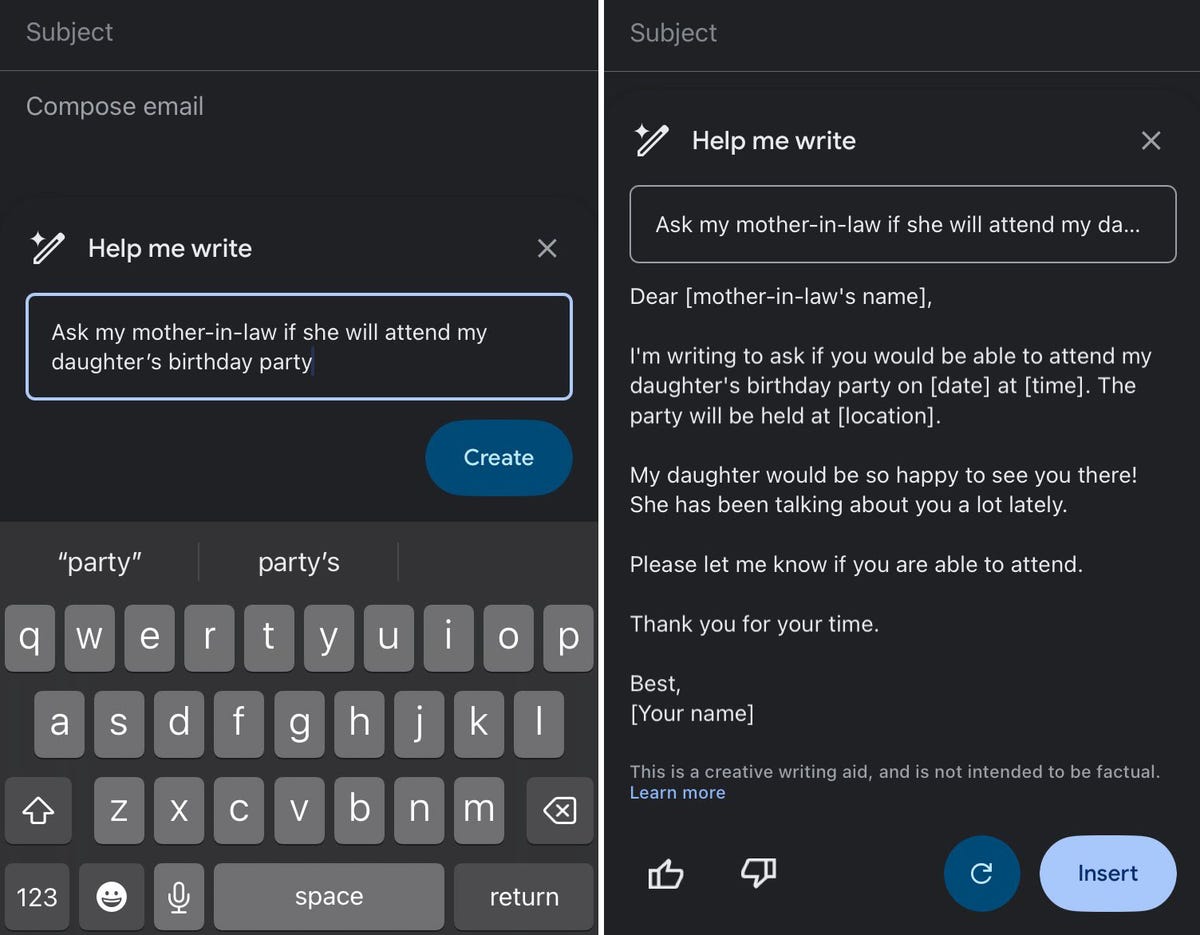
Gmail’s Help Me Write feature on iPhone shows up as a button at the bottom of new emails.
For more, here’s what to know about Google’s Bard AI and the company’s AI-powered search engine.
Technologies
Today’s NYT Mini Crossword Answers for Saturday, Nov. 1
Here are the answers for The New York Times Mini Crossword for Nov. 1.
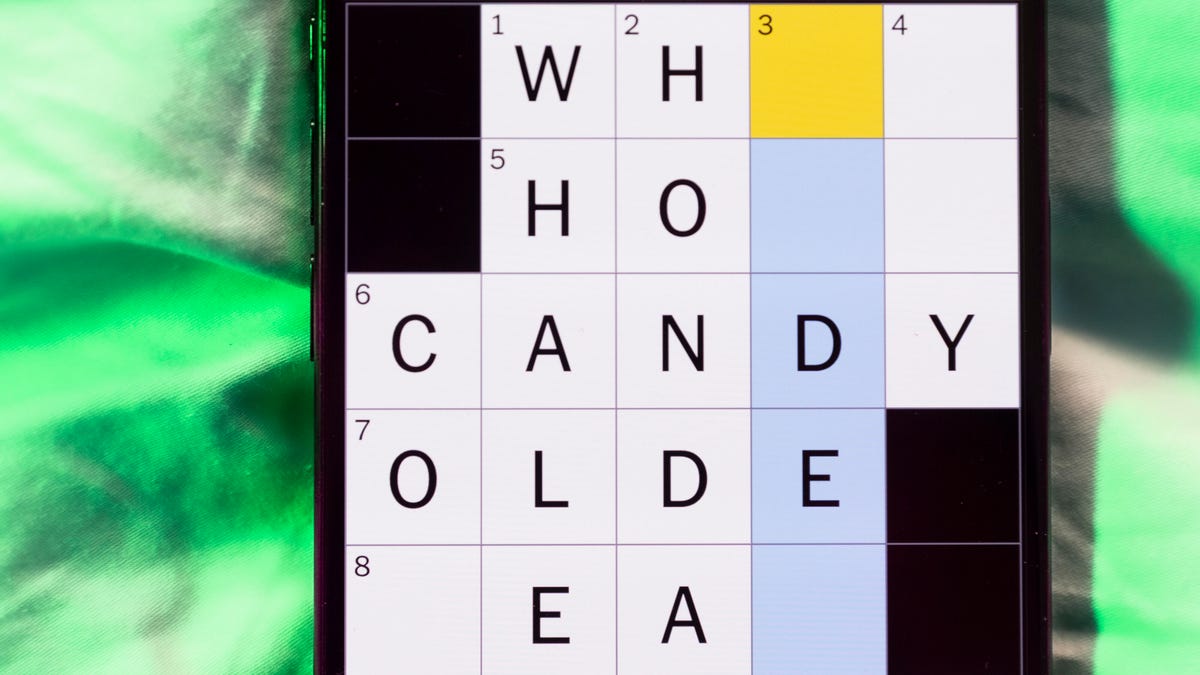
Looking for the most recent Mini Crossword answer? Click here for today’s Mini Crossword hints, as well as our daily answers and hints for The New York Times Wordle, Strands, Connections and Connections: Sports Edition puzzles.
Need some help with today’s Mini Crossword? It’s the big Saturday version, so it could take some time. Read on for the answers. And if you could use some hints and guidance for daily solving, check out our Mini Crossword tips.
If you’re looking for today’s Wordle, Connections, Connections: Sports Edition and Strands answers, you can visit CNET’s NYT puzzle hints page.
Read more: Tips and Tricks for Solving The New York Times Mini Crossword
Let’s get to those Mini Crossword clues and answers.
Mini across clues and answers
1A clue: Ethically sourced, as some egg
Answer: CAGEFREE
9A clue: Residents of Tehran
Answer: IRANIANS
10A clue: Air sign?
Answer: SKYWRITE
11A clue: ___ Faire (medieval-themed festival, informally)
Answer: REN
12A clue: Athlete from Cleveland or the University of Virginia
Answer: CAVALIER
17A clue: Kind of bathing suit
Answer: ONEPIECE
18A clue: Musical whizzes
Answer: MAESTROS
Mini down clues and answers
1D clue: Certain gender identity
Answer: CIS
2D clue: Holy object sought in the first «Indiana Jones» movie
Answer: ARK
3D clue: ___ pride
Answer: GAY
4D clue: Completely surrounds
Answer: ENWRAPS
5D clue: Like a cozy campsite on a cool autumn night, say
Answer: FIRELIT
6D clue: Washington’s Mount ___, the highest peak in the Cascades
Answer: RAINIER
7D clue: Sinus-treating doctor, for short
Answer: ENT
8D clue: Opposite of WNW
Answer: ESE
12D clue: _ _ _mon URL ending
Answer: COM
13D clue: De Armas who starred in 2025’s «Ballerina»
Answer: ANA
14D clue: Shape of flying geese
Answer: VEE
15D clue: Prefix with friendly
Answer: ECO
16D clue: Restaurant booking, informally
Answer: RES
Technologies
Kim Kardashian Denies the Moon Landing and NASA Corrects Her Publicly
It’s one reality TV actor versus another, as Real World alum and acting NASA administrator Sean Duffy tells Kardashian she’s wrong.

NASA says we’ve been to the moon six times. Kim Kardashian says the first time was faked. On a recent episode of The Kardashians, the reality-show star was chatting with actress Sarah Paulson about astronaut Buzz Aldrin, the second man to walk on the moon. That’s when Kardashian revealed she doesn’t believe the 1969 moon landing is real.
Don’t miss any of our unbiased tech content and lab-based reviews. Add CNET as a preferred Google source.
In an interview, Aldrin was asked about the scariest moment of the Apollo 11 mission. Kardashian quotes his reply, «There was no scary moment because it didn’t happen. It could’ve been scary, but it wasn’t because it didn’t happen.»
It’s unclear which interview this was, or what exactly Aldrin was referring to, although it seems like he’s saying a certain frightening moment didn’t come to pass. But Kardashian took the quote to mean the entire moon landing was a hoax that Aldrin chose to reveal via that one quote.
«So I think (the moon landing) didn’t happen,» she said.
NASA acting administrator (and former participant on reality show The Real World) Sean Duffy took exception to the sentiment, replying on X «Yes, Kim Kardashian, we’ve been to the moon before…6 times!»
Yes, @KimKardashian, we’ve been to the Moon before… 6 times!
And even better: @NASAArtemis is going back under the leadership of @POTUS.
We won the last space race and we will win this one too 🇺🇸🚀
🎥: Hulu pic.twitter.com/CkexEEPFSv— NASA Acting Administrator Sean Duffy (@SecDuffyNASA) October 30, 2025
The US did in fact land on the moon on July 20, 1969, with Aldrin and fellow astronaut Neil Armstrong both walking on the lunar surface. Armstrong died in 2012. Aldrin is now 95.
In 2002, Aldrin, then 72, punched a conspiracy theorist who tried to get him to swear the moon landings was faked.
«We won the last space race and we will win this one too!» Duffy told Kardashian on X. He later invited her to an upcoming launch at Kennedy Space Center, though she did not immediately accept.
Kardashian did not respond to a request for comment.
Technologies
Tesla’s New Range of Affordable Electric Cars: Here’s How Much They Cost
The stripped-down versions of the Model Y and Model 3 come with a lower price point.
-

 Technologies3 года ago
Technologies3 года agoTech Companies Need to Be Held Accountable for Security, Experts Say
-

 Technologies3 года ago
Technologies3 года agoBest Handheld Game Console in 2023
-

 Technologies3 года ago
Technologies3 года agoTighten Up Your VR Game With the Best Head Straps for Quest 2
-

 Technologies4 года ago
Technologies4 года agoVerum, Wickr and Threema: next generation secured messengers
-

 Technologies4 года ago
Technologies4 года agoBlack Friday 2021: The best deals on TVs, headphones, kitchenware, and more
-

 Technologies4 года ago
Technologies4 года agoGoogle to require vaccinations as Silicon Valley rethinks return-to-office policies
-

 Technologies4 года ago
Technologies4 года agoOlivia Harlan Dekker for Verum Messenger
-

 Technologies4 года ago
Technologies4 года agoiPhone 13 event: How to watch Apple’s big announcement tomorrow

